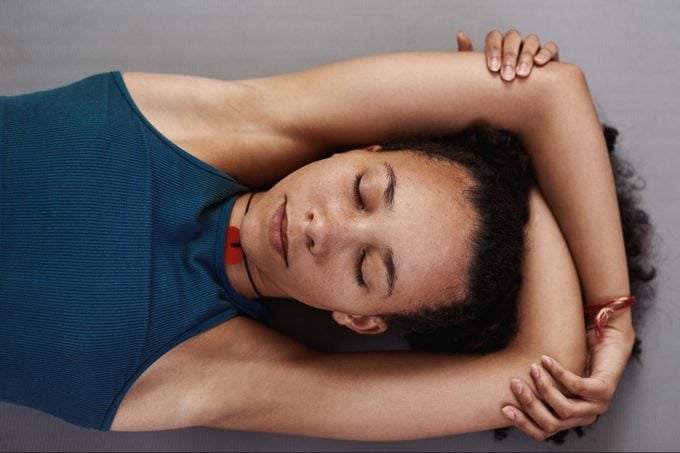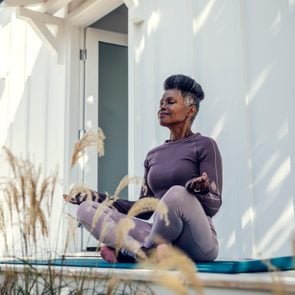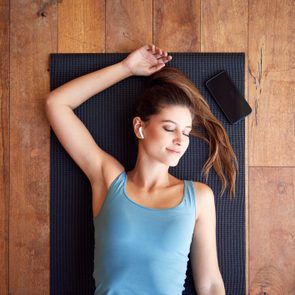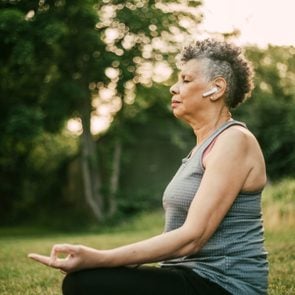Meditate Lying Down? Yes You Can—Here’s How
Updated: Jun. 09, 2021
Some people believe that lying down to meditate is a bad idea: Meditation pros explain why it's not—and how being supine could be right for you.
Can you meditate lying down?
How popular is meditation in the United States? Consider this: About 38 percent of Americans say they practice meditation or mindfulness at least sometimes, a 2020 Morning Consult survey found.
And meditation apps like Calm and Headspace account for slightly over a third of all the health apps bought by Americans this past year, according to Statista, a site that compiles marketing data.
The popularity of meditation makes sense, given all the benefits of meditation.
Research found that the practice can lower blood pressure and stave off cognitive decline, according to Mindfulness and the Journal of Alternative and Complementary Medicine.
It definitely helps reduce anxiety and depression by making people more resilient, another study in Frontiers in Psychology found.
So if you’re thinking, “Sign me up!” and then wondering how to start meditating, just lie down.
“If you’re a beginner, it is a wonderful way to start because lying down requires the least amount of effort for your body physically,” says Tatyana Souza, a yoga and meditation teacher and owner of Coolidge Yoga in Brookline, MA.
Sometimes sitting, especially in a cross-legged position, can be uncomfortable, Souza adds.
“So when you take the position out of the equation by lying down on your back, the mind is not worried about the tightness in the hips, the tightness in the ankles, and it can just focus on the task at hand, which is the meditation practice.”
Read on to find the proper way to align your body, the benefits of being in the supine pose, and some easy meditation and mindfulness practices you can do lying down.
How to meditate lying down or in bed
“Comfort is queen,” says Josephine Atluri, a meditation coach and teacher in Los Angeles, who says choosing a comfortable meditation position is the best way to pick which one works for you.
“You want to prioritize that feeling because you want to be able to sustain your practice not only for that particular meditation but also throughout—you want to be able to keep coming back to it because it’s a beneficial experience for you.”
(Check out the 5 ways to turn meditation into a daily habit.)
To get into the proper position on the bed or mat, do the following:
Use props if you want
“Have pillows underneath your knees to support your spine and elevate your feet, especially if they tend to fall asleep,” suggests Atluri. “You can put a pillow under your neck also to support proper alignment.”
If you’re antsy, she also suggests draping a weighted blanket on your body, and an eye mask if you have problems closing your eyes.
If you’re on a mat, Souza recommends taking a blanket and folding it lengthwise so that it acts as a bolster to support your spine from tailbone to crown. That can help you breathe more fully, too, she notes.
Open your chest
“Move your shoulders to pull them down away from your ears and roll them back,” Atluri suggests.
“When you do that, almost like you’re pressing your shoulders and your back into the ground, is that your chest sort of pops up a little bit, and that’s great for releasing some stress and anxiety.”
Support your spine
“It’s nice to have the spine fully extended, so you want support to be from your tailbone all the way to the crown of the head,” says Souza.
“And you want space on either side of the spine so that the arms can be in a comfortable, relaxed position.”
Let your legs fall where they may
Let your legs and feet fall naturally.
However, there are some other options, according to Souza.
“The legs can be fully extended, like in corpse position, or you can have the knees bent,” Souza says. “Sometimes I really like soles of my feet together, and knees open like a book, like a butterfly pose. So there are leg variations, but you really want the spine to be long.”
Relax into the position
“Make a mental checklist as you work your way up from your feet to the top of your head to see where you might be holding onto tension,” Atluri advises.
The goal is to be in the most open and receptive position as possible as you practice, she adds.
Some other meditation tips are relaxing into meditation lying down, including unclenching your hands and jaw, and relaxing your toes and belly—they might be unknowingly tight.
“Often people have their hands squeezed tight because they’re so used to typing and holding their phones,” Atluri says.
“Soften the corners of your eyes, because we’re squinting all the time by looking at screens, along with your forehead,” she continues.

The best meditations to do while laying down
Now that you’re in position, here are some of the best meditations to do while lying down or in bed. Guided meditation for pre-bedtime is available on some free meditation apps, too. Consider reading about the various types of meditation to see which ones appeal to you.
A body scan
“My favorite one is the body scan where you’re just breaking down the body inch by inch and really just checking in to the different sensations and qualities to the different parts of the body,” says Dora Kamau, a meditation and mindfulness teacher in Vancouver, Canada, and a teacher for Headspace.
“Start at the top of your head and work your way down to the soles of your feet, taking inventory of what’s there, what feels good or tense or tight.”
Of course, you can scan as you sit. But the beauty of lying down is that you’re working your way through each body part where everything is sort of even, says Atluri.
“So it’s not like you’re putting a lot of pressure on your seat because you’re sitting, and then you kind of lose contact with other parts of your body,” she notes.
Mindful breathing
To breathe mindfully is always a good way to start a practice, especially when laying down for meditation.
“I find lying down with my hand on my stomach allows me to really tune in into that sensation of the rising and falling of my chest and my stomach as I breathe in and out,” says Kamau. “So you’re able to really pay attention and not, like, feeling the ache in your back or discomfort in your hip.”
As you pay attention to the breath, you stop focusing on your racing thoughts, so it can reduce stress and anxiety, Kamau notes.
To make this practice even easier, simply label your breath, Souza suggests. “Every time you inhale, you just give it a quick label—’inhaling’ or ‘breathing in’—and then as you’re exhaling, same thing—’exhaling’ or ‘breathing out,'” she explains.
As your mind wanders (it’s part of the process), you just come back to your breath and say, “Oh, I’m inhaling.”
Focusing on an affirmation
You don’t only have to focus on your breath. You can pick a mantra (a word or sound) or an affirmation.
Souza recommends focusing on something positive that you want to bring into your day first thing in the morning.
Some examples of affirmations that you can repeat as you inhale and exhale are “I am safe” or “I am loved” or “I am at peace” or “I am strong and confident,” she notes.
“Practicing positive affirmation during meditation can help to remind you of your strengths, of your support system, and of the good things that you have within you. You may have to try a few to see which one resonates and works for you, and that may also shift and change over time,” she notes.
The bottom line, the more tools, the better.
The benefits of meditation lying down
You really concentrate on breathing
Sure, we inhale and exhale a gajillion times a day, but many meditation practices use the breath as a rope to tether the mind, Souza explains.
And lying down is the perfect position to help you pay attention to your breath.
“It gives you maximum opportunity to expand the diaphragm and the rib cage and really focus on the three-dimensional aspect of their breath,” she notes.
It’s a good way to wind down before z’s…
There’s some evidence that mindfulness meditation can improve the quality of sleep, and help you drift off faster, according to a review in the Journal of Psychosomatic Research.
So if you’re already there, why not do a quick practice meditation lying down in bed.
“You’re cozy, and you’re preparing the body to rest,” Kamau says.
Plus, with the bed supporting you, you’re able to tune into the state of your body, relax more easily and focus on your breath, she adds.
…And an excellent way to start your day
Most of us reach for our phones as soon as we wake up. But what if you stayed in bed and focused on the breath? Souza poses this question admitting that she really likes meditating before bed and first thing in the morning, calling it “little meditation sleep-sandwich.”
“I think it’s a nice break between sleep and technology,” Souza explains. “If you wake up and just take five minutes to focus on the breath and hone the mind, you wake up more clear, more peaceful, more optimistic. As opposed to checking emails on your phone and suddenly your brain is bombarded with what’s next.”
(Here’s a 5-minute meditation you can try.)
You’re less likely to blow off meditation
This is one position (and location) that makes it easy for you to sneak in a quick practice, says Souza.
“If you’re lying down and still in bed, you can’t talk yourself out of it. You can’t say like, ‘Oh, I’m too tired to meditate.'”
Now that you have the basics down, it’s time to do some specific practices—in bed or out.
“In general, any meditation can be done seated and upright or else lying down,” says Atluri. But some lend themselves especially well in a lying-down position.
Keep these benefits of meditation in mind. They may motivate you to keep up with meditation while lying down or in bed. And remember to focus on your breathing and relax into the position.
Next, check out these mini-meditations to ease stress and anxiety.













